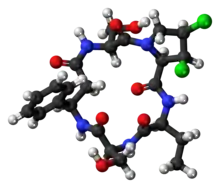Cyclochlorotine
Cyclochlorotine[1] (CC), also known as islanditoxin[2] is a mycotoxin produced by the fungus Penicillium islandicum[3] that causes liver damage and has carcinogenic properties.[4] Japanese researchers confirmed that it was one of three strains of Penicillin fungi responsible for yellowed rice.[2] It is listed as an IARC Group 3 carcinogen.
 | |
 | |
| Names | |
|---|---|
| IUPAC name
1,2-Dichloro-15-ethyl-5,12-bis-hydroxymethyl-9-phenyl-dodecahydro-3a,6,10,13,16-pentaaza-cyclopentac
yclohexadecene-4,7,11,14,17-pentaone | |
| Other names
Cyclo[(R)-3-phenyl-β-alanyl-L-seryl-(2α,3α,4α)-3,4-dichloro-L-prolyl-L-2-aminobutanoyl-L-seryl]; Yellowed rice toxin | |
| Identifiers | |
3D model (JSmol) |
|
| ChemSpider | |
| KEGG | |
PubChem CID |
|
| UNII | |
CompTox Dashboard (EPA) |
|
| |
| |
| Properties | |
| C24H31Cl2N5O7 | |
| Molar mass | 572.44 g·mol−1 |
Except where otherwise noted, data are given for materials in their standard state (at 25 °C [77 °F], 100 kPa). | |
| Infobox references | |
Chemically, it is a dichlorinated cyclic peptide.[5] Structurally, the only thing that differentiates cyclochlorotine from the plant-derived astins of Aster tataricus, is replacement of a serine with a second 2-aminobutyrate.[6]
Cyclochlorotine are one of the toxins usually found in foods in the grains group like rice , wheat, soybeans, peanuts , beans, bread and flour etc. Such foods serve as medium for the growth of molds like Penicillium islandicum which in turn releases toxins like cyclochlorotine etc.[7] Research shows the detailed biosynthesis of Cyclochlorotine which is a multi step mechanism and makes use of a vital component in the last step known as NRPS ( CctN) which helps produce the desired Cyclochlorotine. [8]
References
- Zhou, ZH; Komiyama, M; Terao, K; Shimada, Y (1994). "Effects of cyclochlorotine on myofibrils in cardiomyocytes and on actin filament bundles in fibroblasts in vitro". Nat. Toxins. 2 (6): 378–85. doi:10.1002/nt.2620020607. PMID 7704452.
- Kushiro, Masayo (2015). "Historical review of researches on yellow rice and mycotoxigenic fungi adherent to rice in Japan". JSM Mycotoxins. 65: 12–23. doi:10.2520/myco.65.19.
- "Toxicology of Penicillium islandicum". Nature. 191 (4791): 864–865. 1961. Bibcode:1961Natur.191..864.. doi:10.1038/191864b0. S2CID 38045877.
- Penicillium islandicum causes hepatic necrosis and has carcinogenic properties
- Kohei Mizutani; Yusuke Hirasawa; Yoshiko Sugita-Konishi; Naoki Mochizuki; Hiroshi Morita (2008). "Structural and conformational analysis of hydroxycyclochlorotine and cyclochlorotine, chlorinated cyclic peptides from Penicillium islandicum". J. Nat. Prod. 71 (7): 1297–1300. doi:10.1021/np800150m. PMID 18558744.
- Schafhauser, Thomas; Kirchner, Norbert; Kulik, Andreas; Huijbers, Mieke M. E.; Flor, Liane; Caradec, Thibault; Fewer, David P.; Gross, Harald; Jacques, Philippe (2016-11-01). "The cyclochlorotine mycotoxin is produced by the nonribosomal peptide synthetase CctN in Talaromyces islandicus ('Penicillium islandicum')" (PDF). Environmental Microbiology. 18 (11): 3728–3741. doi:10.1111/1462-2920.13294. ISSN 1462-2920. PMID 26954535.
- Gosh, Anil; Manmade, Awinash; Townsend, James; Bousquet, Ann; Howes, John; Demain, Arnold (June 1978). "Production of Cyclochlorotine and a New Metabolite, Simatoxin, by Penicillium islandicum Sopp". American Society for Microbiology. 35 (6): 1074–1078. doi:10.1128/AEM.35.6.1074-1078.1978. PMC 242987. PMID 677874.
- Schafhauser, Thomas; Kirchner, Norbert; Kulik, Andreas; Huijbers, Mieke; Flor, Liane; Caradec, Thibault; Fewer, David; Gross, Harald; Jacques, Philippe; Jahn, Linda; Jokela, Jouni (March 2016). "The cyclochlorotine mycotoxin is produced by the nonribosomal peptide synthetase CctN in Taralomyces islandicus ( ' Penicillium islandicum')" (PDF). Environmental Microbiology. 18 (11): 3728–3741. doi:10.1111/1462-2920.13294. PMID 26954535.